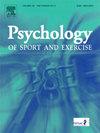Athlete burnout and biomarkers: An exploratory, longitudinal N-of-1 study
IF 3.3
2区 心理学
Q2 HOSPITALITY, LEISURE, SPORT & TOURISM
引用次数: 0
Abstract
Burnout is an increasingly common problem among athletes. In addition to negatively affecting mental health, burnout may also be related to changes in physiological functioning. Research outside of sport suggests that the hypothalamus-pituitary-adrenal (HPA) axis, immune, anabolic, and cardiovascular systems, in particular, may be affected. However, few studies have explored the relationship between burnout and biomarkers of these systems in athletes. Consequently, the aim of the present multidisciplinary study was to explore the relationship between athlete burnout and acute and chronic biomarkers using a longitudinal N-of-1 design. Following a pre-registered protocol with open data, code, and materials, in two athletes, we examined burnout and acute salivary biomarkers (cortisol, testosterone, dehydroepiandrosterone-sulphate [DHEA-S], secretory Immunoglobulin A [sIgA], and C-reactive protein) in 12 samples over six months. In another two athletes, we examined burnout and chronic biomarkers from hair and blood (hair cortisol, glycated haemoglobin [HbA1c], triglycerides, total cholesterol, high-density lipoprotein cholesterol, and DNA methylation in the BDNF, SLC6A4, and NR3C1 genes) in six samples over 12 months. Dynamic regression modelling showed that burnout symptoms predicted decreased testosterone and developed simultaneously with decreases in DHEA-S and sIgA. Visual analyses suggested that burnout symptoms also developed in conjunction with increases in HbA1c and SLC6A4 methylation and preceded increases in hair cortisol and BDNF methylation. Our findings provide a preliminary “physiological fingerprint” that could help explain athlete burnout development and consequences which can be used to guide future theory and research in this area.
运动员倦怠和生物标志物:一项探索性的纵向N-of-1研究。
职业倦怠是运动员中越来越普遍的问题。除了对心理健康产生负面影响外,倦怠还可能与生理功能的变化有关。运动以外的研究表明,下丘脑-垂体-肾上腺(HPA)轴、免疫系统、合成代谢系统和心血管系统尤其可能受到影响。然而,很少有研究探索运动员倦怠与这些系统的生物标志物之间的关系。因此,本多学科研究的目的是利用纵向N-of-1设计来探索运动员倦怠与急慢性生物标志物之间的关系。根据预先注册的开放数据、代码和材料,我们对两名运动员进行了为期六个月的倦怠和急性唾液生物标志物(皮质醇、睾酮、脱氢表雄酮硫酸盐[DHEA-S]、分泌性免疫球蛋白a [sIgA]和c反应蛋白)检测。在另外两名运动员中,我们在12个月的时间里检测了6个样本的头发和血液中的疲劳和慢性生物标志物(毛发皮质醇、糖化血红蛋白[HbA1c]、甘油三酯、总胆固醇、高密度脂蛋白胆固醇以及BDNF、SLC6A4和NR3C1基因中的DNA甲基化)。动态回归模型显示,倦怠症状预示着睾酮水平的下降,并与DHEA-S和sIgA水平的下降同时发生。目视分析表明,倦怠症状也与HbA1c和SLC6A4甲基化升高同时出现,并先于毛发皮质醇和BDNF甲基化升高。我们的研究结果提供了一个初步的“生理指纹”,可以帮助解释运动员倦怠的发展及其后果,并可用于指导该领域未来的理论和研究。
本文章由计算机程序翻译,如有差异,请以英文原文为准。
求助全文
约1分钟内获得全文
求助全文
来源期刊
CiteScore
6.40
自引率
5.90%
发文量
172
审稿时长
69 days
期刊介绍:
Psychology of Sport and Exercise is an international forum for scholarly reports in the psychology of sport and exercise, broadly defined. The journal is open to the use of diverse methodological approaches. Manuscripts that will be considered for publication will present results from high quality empirical research, systematic reviews, meta-analyses, commentaries concerning already published PSE papers or topics of general interest for PSE readers, protocol papers for trials, and reports of professional practice (which will need to demonstrate academic rigour and go beyond mere description). The CONSORT guidelines consort-statement need to be followed for protocol papers for trials; authors should present a flow diagramme and attach with their cover letter the CONSORT checklist. For meta-analysis, the PRISMA prisma-statement guidelines should be followed; authors should present a flow diagramme and attach with their cover letter the PRISMA checklist. For systematic reviews it is recommended that the PRISMA guidelines are followed, although it is not compulsory. Authors interested in submitting replications of published studies need to contact the Editors-in-Chief before they start their replication. We are not interested in manuscripts that aim to test the psychometric properties of an existing scale from English to another language, unless new validation methods are used which address previously unanswered research questions.

 求助内容:
求助内容: 应助结果提醒方式:
应助结果提醒方式:


